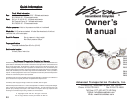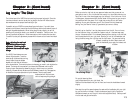
9
Chapter 2: (Continued)Chapter 2: (Continued)
Chapter 2: (Continued)Chapter 2: (Continued)
Chapter 2: (Continued)
Final InspectionFinal Inspection
Final InspectionFinal Inspection
Final Inspection
Before each ride be sure to inspect all theBefore each ride be sure to inspect all the
Before each ride be sure to inspect all theBefore each ride be sure to inspect all the
Before each ride be sure to inspect all the
nuts and bolts on the bike, looking for anynuts and bolts on the bike, looking for any
nuts and bolts on the bike, looking for anynuts and bolts on the bike, looking for any
nuts and bolts on the bike, looking for any
parts that may have loosened.parts that may have loosened.
parts that may have loosened.parts that may have loosened.
parts that may have loosened.
Check the alignment of the wheels, and inspect theCheck the alignment of the wheels, and inspect the
Check the alignment of the wheels, and inspect theCheck the alignment of the wheels, and inspect the
Check the alignment of the wheels, and inspect the
brakes to make sure the shoes contact the rimsbrakes to make sure the shoes contact the rims
brakes to make sure the shoes contact the rimsbrakes to make sure the shoes contact the rims
brakes to make sure the shoes contact the rims
squarely and don't bind.squarely and don't bind.
squarely and don't bind.squarely and don't bind.
squarely and don't bind.
The handlebars should be aligned and able to turnThe handlebars should be aligned and able to turn
The handlebars should be aligned and able to turnThe handlebars should be aligned and able to turn
The handlebars should be aligned and able to turn
from side to side without binding or interference.from side to side without binding or interference.
from side to side without binding or interference.from side to side without binding or interference.
from side to side without binding or interference.
Check that the wheel skewers are secure, and that aCheck that the wheel skewers are secure, and that a
Check that the wheel skewers are secure, and that aCheck that the wheel skewers are secure, and that a
Check that the wheel skewers are secure, and that a
sharp blow on the wheel while you hold the bike offsharp blow on the wheel while you hold the bike off
sharp blow on the wheel while you hold the bike offsharp blow on the wheel while you hold the bike off
sharp blow on the wheel while you hold the bike off
the ground will not jar the wheel loose.the ground will not jar the wheel loose.
the ground will not jar the wheel loose.the ground will not jar the wheel loose.
the ground will not jar the wheel loose.
Check that all seat and wheel skewers are secure.Check that all seat and wheel skewers are secure.
Check that all seat and wheel skewers are secure.Check that all seat and wheel skewers are secure.
Check that all seat and wheel skewers are secure.
See Chapter 1 for more details.See Chapter 1 for more details.
See Chapter 1 for more details.See Chapter 1 for more details.
See Chapter 1 for more details.
12
Riding a Vision recumbent is no more difficult
than riding a traditional diamond frame bicycle,
just slightly different. If you are new to cycling,
you’ll find it easy to learn to ride on a Vision. If
you are an experienced rider, you’ll have to learn
some new habits, but the benefits of riding a
recumbent far outweigh the small learning curve
involved. Either way, it’s important to spend a
little time adjusting to your new bike before
riding in traffic or committing to a long ride. In
this chapter I’m going to discuss some things
that will make the transition to recumbents, or
learning to ride on a recumbent, easier.
First of all, be sure to read the previous chapter about set up of the bike. To ride
well you have to be comfortable, and to be comfortable you need to be sure that
your Vision is adjusted to fit you properly. The seat angle is adjustable, and
really affects how you feel on the bike. If you’re just starting out with recumbents
you will probably want to set the seat as upright as possible. Later you can
recline the seat incrementally until you find your own ideal position.
If you’re comfortable on your bike, it’s time to go riding. First and foremost, the
most important part of riding any bike is to wear proper safety equipment. We
discussed safety equipment in Chapter 1, but I will repeat it here. It is essential
to wear a helmet, all the time, anytime you ride. It’s also very important to wear
gloves when you ride. If you do have an accident and fall over, you’ll probably
catch yourself with your hands, so save your palms and wear gloves. You should
also wear protective eyewear; road grit and flying insects do not make for happy
eyes. Wearing cycling shoes, shorts and jerseys can help you be more
comfortable, but they are not as essential as the helmet, gloves and glasses.
Now you’re all set to hop on your Vision and pedal away into the sunset, right?
Wrong! The key to riding smoothly and in a controlled fashion on any bicycle,
recumbent or not, is to be comfortable enough to relax. If you are nervous and
tense, you will tend to ride in a jerky, overcontrolling fashion. Not only does this
make you more uncomfortable, which leads to even worse riding, but it doesn’t
look cool. So you need to approach the bike as your friend, someone you’ll enjoy
spending the day with. The intent here is to spend some unpressured time
getting to know your bike before you get 20 miles into nowhere, or involved with
city traffic. Pack a lunch and head for the park, relax and enjoy the day for a bit,
and then set yourself up to ride in the parking lot, or any open space with no
traffic.
Chapter 3: Riding the VISIONChapter 3: Riding the VISION
Chapter 3: Riding the VISIONChapter 3: Riding the VISION
Chapter 3: Riding the VISION












